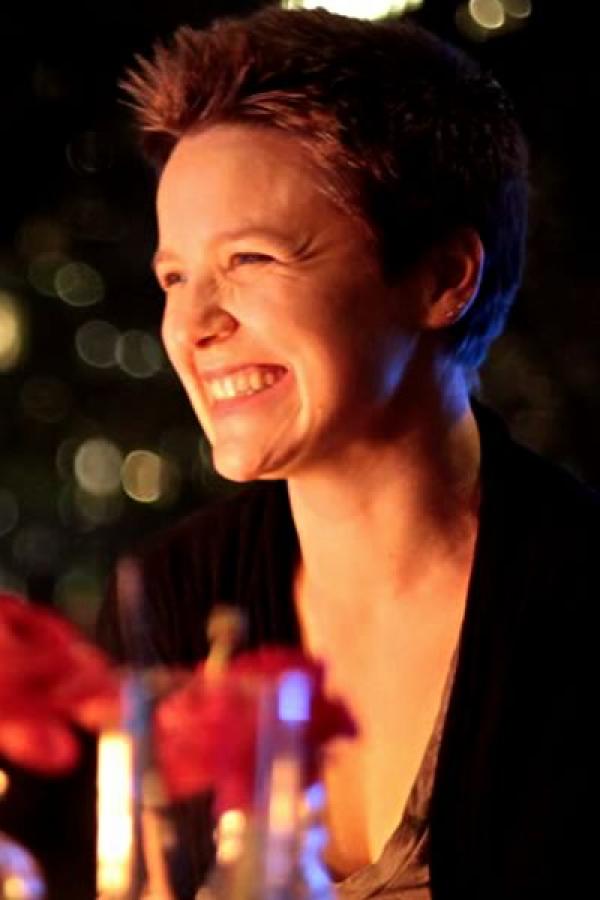Anna Rosenwong

Photo by Jesse Chan Norris
Bio
Anna Rosenwong is a translator, poet, editor, and educator. Her translation of Rocio Ceron's Diorama won the Best Translated Book Award, and a major collection of Jose Eugenio Sanchez's poems, Here the Sun's for Real, is forthcoming in March 2018. She has received fellowships from the Banff International Literary Translation Centre and the American Literary Translators Association, and is the translation editor of Anomaly. Her scholarly and creative work has been featured in such venues as World Literature Today, The Kenyon Review, and Modern Poetry Today.
In El ombligo del cielo, renowned Uruguayan poet, novelist, and journalist Rafael Courtoisie maps the magical universe of a small city at the center, the crossroads, “on the cross” of the beautiful, troubled country of Chile. During a three-week residency in La Calera, Courtoisie felt himself being trailed by the ghost of Roberto Bolaño, compelling him to write something like a Borgesian “ficción”—an often poetic, often vulgar text blending reality and dizzying surreality.
I first met Rafael when he was a guest of Iowa’s International Writing Program in 2006, and I’ve translated his poems intermittently in the years since. When he sent me this dense, irreverent novel, I immediately knew I wanted to bring it to English-language readers. After translating the intoxicating first chapter, I showed it to my frequent collaborator, María José Giménez, and asked if she’d like to tackle the rest with me. Unfortunately, as overextended freelancers, we could make only the most fitful progress on this literary passion project, with paid gigs always taking priority. An NEA Fellowship was precisely what we needed to make our translation possible, and it is an honor and a joy to finally give El ombligo del cielo the attention and the wider audience it deserves.
From El ombligo del cielo by Rafael Courtoisie
[translated from the Spanish]
Uf. Enough about my late and dear friend Bolaño, enough with the digressions. Let’s get back to the Devil, who, as I just mentioned, invented the dictionary.
When God feels like it, he lets the Devil out.
And out the Devil comes. Yes, the fat man, the horned one, the rogue, the shockjock, the renegade, the fool, pinky, the red shepherd, the pus drunkard, the rodent, the mule, the always-gotcha, the broken cherub, the bitter, the sour, the wellspring of poison, the big goat, never the little goat, the purulent, the gimp, old two-tails, the toad’s roar, the brooding hen’s feet, the dickhead, Mr. uses-you-for-target-practice, you see, the governor of the depths, the owner of the lime mines, the owner, since before homo sapiens even existed, of all Chile’s copper and South Africa’s diamonds, Colombia’s emeralds, agates, amethysts, and what’s more, purely out of greed, you see, out of stinginess at being nothing more than the damned, the hoarder of all the worthless rocks he can get his hands on in his monolithic, crumbling subsoil beneath the Oriental Republic of Uruguay.
The Devil emerges through the cracks that form here and there in the Earth’s crust, on various continents, islands, and archipelagos spread all around the planet.
On Chiloé Island, they know him well.
On Easter Island, they know him well.
On Robinson Crusoe’s island, they know him well.
They’ve spotted him in Gothenburg, in Leipzig, in a grotto north of London, in the Roman catacombs; in a cave on Mount Avila in Caracas; in the basement of a gigantic Tel Aviv mall; in a puddle in the middle of the Colombian Amazon near Leticia; in Prague, right near the astronomical clock, in a passageway under one of the houses Franz Kafka lived in before he turned into a cockroach, a room the Nazis would later use as a holding pen—before deportation and extermination—for Jews they’d hunted up on the surface of Prague, where the Golem failed to defend them, but the Prague Golem never did anything, because there was nothing it could do.
In the city of Salamanca, Spain, I myself once descended to the basement of an inconceivably old church where the fucker appeared disguised as a young student: he wore a mask, the face innocent and manly, but with the lightest touch of femininity—the ambiguity making him even more attractive, a combination, shall we say, of Brad Pitt at his peak, before he went on the Atkins diet and divorced the woman he loved most, and Di Caprio’s face in the final shot of Titanic.
The Devil disguises himself and sets about seducing college girls with artificially sweetened words and black magic. After conning them, the disguised Devil carries them to the banks of the Tormes—the river where Lazarillo assaulted his blind charge, who cracked his head open on the bridge—and on those steamy shores, in spring, sheltered by the foliage and flowering brush, he engages in carnal relations with those Spanish or Latin American damsels, and fills them with his black milk even though they use a condom, and even though they use a condom, he infects them with envy, gonorrhea of worry, HPV, the illness of anxiety, which attacks the bones, glands, and glandules, and within a few years will turn these graceful ladies into bitter, rough, ailing old hags.
But back to La Calera.
The Devil loves to come out in La Calera.
About Rafael Courtoisie
A translator and author of more than 30 novels and books of poetry and essays, Courtoisie (b. 1958) is one of Uruguay's most decorated living authors. He is the recipient of, among many other prizes, both the Uruguayan Ministry of Culture's Poetry Award and its Prose Award. This novel was born from the author's visit to La Calera, Chile, where he felt guided through the city by the ghost of writer Roberto Bolaño and asked to write a book that blends reality and surreality. The result is a universe populated with beings both imaginary and easily recognized, including Gabriela Mistral, Pablo Neruda,

